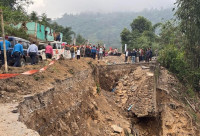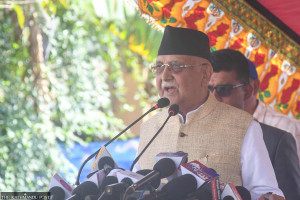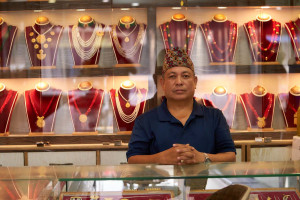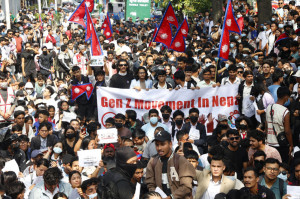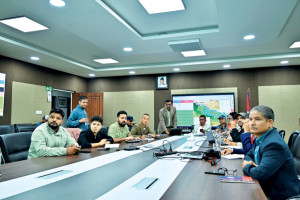Opinion
Interconnecting ways
China is a rising power that is confronting an age-old geopolitical problem: What does it do with its new and growing capabilities? How does it project power, and turn power into purpose?
China is a rising power that is confronting an age-old geopolitical problem: What does it do with its new and growing capabilities? How does it project power, and turn power into purpose? How does it gain more control over its geopolitical environment, within Asia and the wider world? These are the few curiosities that the world order is watching from a close range.
The basic tenets of Nepal’s policy towards the rising powers of the North and South are fixed by its geopolitical constraints, hence no deviations would be seen irrespective of the change in leadership. Nepal’s dire investment and economic cooperation needs are quenched by these two Asian powerhouses, and thus, has indeed led towards maintaining peace and stability.
Political discourses conjoining India and China are gaining momentum mainly in the aftermath of an undeclared economic blockade of the year 2015, while soliciting cooperation at the cost of another. In KP Oli’s maiden post electoral Yatra, starting from the Rasuwa border along with a battery of party stalwarts from the CPN-UML, the psuedo-Nationalistic tendency, which he quite often uses as a winning lexicon, might have run high, but no tangible deviation in his future foreign policy can be anticipated. Balanced relation with our neighbors per se, in view of our geopolitical structure and historic affiliations are common man’s wish not endowed by pragmatism, and history is the constant witness to support this truth.
With the phone call from India’s PM Modi to all the top three national party leaders amidst the successful conclusion of the various tiers of elections a few days ago, India seems to have acknowledged the electoral result and future scions of Nepal. Deeming the stability syndrome in governance after a long hiatus, China’s President Xi Jinping, is also in a mood to moot his visit to Nepal in March this year. If this trip materialises, many Belt and Road Initiative (BRI) projects associated with Nepal get fructified. Nepal, as a sovereign state should not miss the opportunities under BRI if they fulfill our modern development aspirations irrespective of our internal political tug of war.
Stepping up to the plate
When Trump’s America appears to be ceding leadership and credibility in the international realms, spanning from climate change to global trade, Xi Jinping is stepping forward to play the role of the global adult. Global leadership is more than composure and good posture. For the last thirty years, the Chinese economy has benefitted enormously from free trade and financial globalisation. During this period, it moved up from the group of low-income countries to the upper middle-income group and eradicated most of its extreme poverty. According to the IMF World Economic Outlook database, when Chinese market reforms started in 1980, the country’s GDP per capita in purchasing power parity (PPP) terms was equal to only 2.5 percent of that of the United States. In 2015, it reached the level of 25.6 percent of US GDP per capita in PPP terms. In 2014, China became the largest world economy as estimated in PPP terms.
A substantial part of the Chinese manufacturing industry has become part of the global value chain. There is also the expansion of Chinese outward investment going beyond traditional resource related projects in developing countries. The largest Chinese corporations need access to the world financial markets to continue their expansion. The emergence of the Asian Infrastructure Investment Bank (AIIB) can be one of the motives to address those issues. They treat this as a platform for cooperation, not a point of conflict between the US and them. To corroborate this perspective, the bank president Jin Liquin says “the motivating factor behind the establishment of AIIB is to deal with the shortfalls of financing for infrastructure investment in Asia and all of the borrowing countries in the future”. China’s experience with the international financial institutions from the 1980s to the mid-1990s shaped the decision to make infrastructure investment a key consideration of the AIIB. Over this period, China borrowed heavily from the World Bank, the Asian Development Bank (ADB), and international capital markets to invest in infrastructure.
Soft power gains
The China-promoted “Belt and Road” Initiative has received increasing recognition and appreciation in the world. Up to now, more than 100 countries and international organisations have been engaged in it. Belt and Road Initiative is an ambitious attempt to unify and build a web of connectivity linked to China on an unprecedented scale. The Asian Development Bank estimates that Asia requires an investment of about $1.7 trillion in infrastructure. The connectivity proposed to be built in BRI is also clearly of benefit to all those countries in Asia who seek better access to markets and supplies. There are continental and maritime connectivity gaps across Eurasia that need to be filled.
Not all projects under the BRI seem economically viable, which suggests that they have been included for geopolitical or other reasons. As one of the BRICS, India holds great development potential and attracts a lot of attention from the world because of its rapid development in recent years. However, India doesn’t rank high in its economic aggregate, economic development level and infrastructure construction. The country also faces big economic disparity and the huge gap between the rich and the poor. Therefore, subject to the construction of the economic corridor with the northern and southern neighbors of Nepal may bring immense benefits to all the participating countries.
The construction of infrastructure and the establishment of regional public goods supply system through Belt and Road will invariably avail Nepal an opportunity to benefit from China’s exploding economic growth. The complementarity of natural resources and economic structure conducive to the economic and trade cooperation is a precondition for enhanced trade relation and financial cooperation. Expanded or improved physical infrastructure, such as transport links and telecommunication, opening up of potential frontiers with necessary services would provide a great leeway to promote bilateral tourism, the cross country drive, trade and People’s movement.
Baral is a consultant in the tourism industry




 23.12°C Kathmandu
23.12°C Kathmandu



